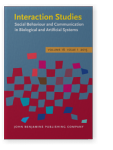Vol. 16:1 (2015) ► pp.29–53
Exploring the effect of a user’s personality traits on tactile communication with a robot using Bayesian networks
Because robots are physically embodied agents, touch is one of the important modalities through which robots communicate with humans. Among the several factors that affect human-robot interaction, this research focuses on the effect of a user’s personality traits on tactile interactions with a robot. Participants interacted freely with a robot and their tactile interaction patterns were analyzed. Several classifiers were used to examine the effect of a participant’s degree of extroversion on tactile communication patterns with the robot and our results showed that a user’s personality traits affected the way in which they interacted with the robot. Specifically, important features of Bayesian networks, such as the Markov blanket and what-if/goal-seeking power were tested and showed the effect of personality on tactile interaction with respect to where and how participants touched the robot. We also found that, by using Bayesian network classifiers, a user’s personality traits can be inferred based on tactile communication patterns.
Article outline
- 1.Related work
- 1.1The effect of personality on social interactions with a robot
- 1.2Tactile communication with a robot
- 1.3General Bayesian network and Markov Blanket
- 2.Method
- 2.1Robot
- 2.2Participants
- 2.3Measurements
- 2.4Procedure
- 2.5Analysis tools
- 2.6Dataset
- 2.7Nodes in classifiers
- 3.Results
- 3.1Study 1: Comparison of classification performance
- 3.2Study 2: Causal relationship between personality and touch
- 4.Discussion
- 5.Concluding remarks
- Acknowledgement
-
References
